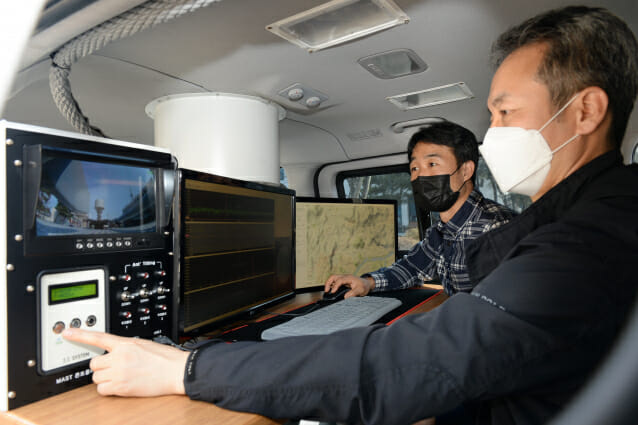
The Electronics and Telecommunications Research Institute (ETRI, Director Myung-Jun Kim) announced on the 25th that it has developed a’mobile radio wave direction detection antenna variable technology’ that can find the radio source precisely while being able to move for the first time in the world. It is expected to be of great help in creating a clean frequency environment while detecting illegal use of radio waves or supplementing blind areas.
The mobile antenna that finds radio signals appearing in various frequency bands is composed of a high-band antenna and a low-band antenna, and is installed on the roof of a vehicle. If the antenna is installed too high, the car cannot be operated stably. For this reason, conventionally, the antenna spacing was fixed to minimize the height. However, there is a problem in that direction detection performance is degraded because the distance between antennas is not enough to avoid interference.
Accordingly, ETRI researchers developed an antenna stacking technology that can adjust the spacing between the high-band antenna and the low-band antenna. When it is not necessary to move or when traveling at a slow speed, the distance between the antennas is increased to detect the direction more precisely, and when moving at a fast speed, the distance is reduced to secure maneuverability.

The next-generation mobile direction finding system developed by ETRI consists of an array antenna, multi-channel receiver and dedicated software. By applying this technology, it is possible to obtain more than twice the accuracy of equipment with fixed antenna spacing. If the azimuth range at which the zone equipment finds radio signals is 2°, the equipment developed by ETRI can be found within the range of 1°, so the direction detection accuracy is higher. When using the technology developed by ETRI, the height of the vehicle is less than 2.5m, making it easier to move than existing vehicles, making it easy to find the location of the radio source anywhere.
The detection range also varies depending on the frequency band and radio wave environment, but it is wide, with several tens of kilometers. It is advantageous for commercialization because it has less volume than before and does not require additional mechanical devices. It is expected that many applications will be used to establish civilian and defense weapon systems that must find the location of radio sources even in situations where national radio wave management services, rescue and disasters such as vehicles and aircraft, and malicious satellite navigation system (GPS) interference occur.
Related Articles

ETRI introduces cutting-edge AI technology to catch crime

ETRI, AI of 22.9% of all patents … 1983 cases in the last 5 years

ETRI succeeds in AR service 30 times faster than before in subway

Young-kwon Kang, CEO of Edison Motors “I will take over Ssangyong…I will make a chairman electric car”
In particular, ETRI explained that its performance is better than the world’s leading companies in the related technology field, so it is evaluated as a core radio wave detection technology that is essential for central radio station, airport corporation, defense-related agencies, and overseas radio wave management agencies. If this technology is transferred to domestic radio wave detection-related companies and defense companies, it is expected that the technology will be localized and export competitiveness can be secured against the global market.
Dr. Son Soo-ho, Radio Environment Monitoring Laboratory at ETRI said, “It is meaningful that we have secured the next-generation mobile direction detection-related core technology for a clean radio environment in the global radio direction detection market, which is dominated by a small number of overseas leading companies.” It will continue to develop follow-up research to develop type radio wave detection technology and to broaden the accuracy and range of direction detection, which was developed in support of the project of the Ministry of Science and ICT’s’Radio Monitoring Specialist Lab’.
